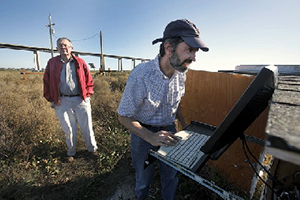
Dennis viewing flux data at his AmeriFlux site at Sherman Island (US-Snd).
I have just stepped down as editor in chief of JGR Biogeosciences. After having handled over a 1000 papers many trends have emerged regarding the quality of papers, the expectations of referees and seeing what published papers become more successful than others. Much of it gets down to writing clearly and presenting new and novel results that are of interest to the community. We are grateful that many past flux papers have met this criterion, but we also want to keep the momentum going and the quality of the next generation of papers high. Below is a list I posted on the JGR Biogeoscience web site. Is it the perfect and final word for writing a better paper, obviously not. But many of the suggestions are worth considering, especially for young scientists.
TEN TIPS FOR WRITING BETTER AND MORE INTERESTING PAPERS
Having served in this editorial post for over three years I have had the opportunity to read through nearly 1000 submissions. This gives me the perspective to see which papers succeed, and don’t. There are occasions when good science papers get better reviews because they are clear and well-written, in comparison to more novel science papers that are poorly written because the referees didn’t understand what the authors had written. In the following I list 10 Tips for writing better and more interesting JGR Biogeosciences papers
1. It is important to write well and write clearly.
Writing well takes work, careful introspection and self-criticism of one’s writing. It also takes a willingness to revise one’s paper over and over again. I am sympathetic to the fact that this is an international journal, whose many authors may not be native English speakers. On the other hand, many papers we receive do not meet a satisfactory level of what is considered to be ‘well-written’, and, consequently, they receive much criticism from referees. With the goal of improving the quality of papers submitted to this journal, I offer my own personal writing experience, as an example. I am not a naturally gifted writer, so I end up revising my papers many times (5 to 15 times is typical) before I submit it to a journal; even this document has undergone numerous drafts. I make this point because I have the impression many papers are submitted to us after very few drafts and revisions. Writing well is not as simple as following rigid rules of grammar. It is my opinion that the refinements in grammar come last; for more information I refer the author to Strunk and White’s Elements of Style, a short, practical book on writing well. In the earliest stages, one should concentrate on writing a clear, compelling and interesting narrative that is scholarly and concise. A well written paper also entails good organization, avoiding redundancy and avoiding the use of jargon and acronyms. Good organization includes knowing what to write, what to leave out and where to place it in the manuscript. Before you start writing, craft a story board or a power point presentation on the figures that should be in the paper and the logical order they should be presented. Crafting good writing follows from reading good writing. This is a lesson I learned from my Professors and is one I want to pass on to others. As future authors, look to papers you admire and observe their style, cadence and content. I also encourage reading well-written, non-science articles in national and general-interest magazines like the New Yorker or Atlantic Monthly. These magazines have a long tradition of publishing articles that are well edited, as well as being well-written. And the articles are written by journalists who know how to tell a compelling story, as opposed to writing in a dense, opaque and boring style. Finally, I encourage authors to have their paper read and reviewed by an independent colleague before submission. This also gives the author time to reflect on their writing and gives them the opportunity read their paper one more time with fresher eyes. We love to get papers that come back with recommendations of minor revision. Doing the hard work of crafting a first rate paper before submission increases the odds of getting favorable reviews.
2. Tell the reader why you are doing this work and what are your over-arching hypotheses and objectives.
It is not good enough to state ‘we made these measurements and want to report them’. Appeal to the readers’, and scientists’, innate curiosity. Remember, good newspaper articles must address who, what, where and when? Good science papers should address what, how many (or how much), how and why?
3. Chose your topic well.
It takes time and effort to write any paper, so focus on writing a paper that is creative and integrative rather than one that treats a narrow and well-tread aspect of biogeosciences. I recognize that we live in a high pressure era of publish and perish, but it is better to produce papers that you will be proud of and will stand the test of time. And it takes nearly as much work to write an ordinary paper that may be ignored and make little advances to the field, as a better paper. The ability to write and publish thoroughly documented papers is what distinguishes JGR from our competitors that publish short letters. The editors of this journal are less interested in papers that make incremental improvements to the science. And we are not interested in papers that are solely reports of data.
4. Report the data in unambiguous units that reflect the time and space frame of measurements.
We receive a mix of units for similar types of measurements. We must comply with international standards of units. For example, chamber-based and eddy covariance flux measurements are reported in terms of mass per meter squared per second or moles per meter squared per second. Units on the order of grams per meter squared per day come only from integrating the flux density over time. They are not the native units of the flux measured by the system over tens of minutes. If mass units are reported please be clear if it is in terms of grams of C per unit CO2, CH4, or unit N per unit N2O. If mass units are used try reporting them as g C-CH4 m-2 s-1 or ng N-N2O m-2 s-1, where relevant, or using the appropriate units. System Internationale standards prefers to see units changing by factors of 103 in naming, e.g. nmol m-2 s-1, mmol m-2 s-1, mmol m-2 s-1, mole m-2 s-1. Fluxes in terms of mg-C m-2 hour-1 are discouraged.
5. Draw clear and compelling figures.
Craft figures with bold legends, axis titles and symbol sizes. Pay attention to aesthetics. Don’t clutter up the graphs with too much data. Produce figures that are as good as the ones you like to see when reading papers you admire.
6. Statistical tests for significance may not yield new or interesting results.
In performing regression analysis, be cognizant of the fact that a regression slope significantly different than zero (P < 0.05) may not be a ‘significant’ finding in the scientific sense of discovering new information and advancing knowledge. Such a regression contains lots of scatter and can yield an r2 less than 0.20. This tells me that the independent variable of regression explains less than 20% of the variation of the dependent variable. This result is not impressive for process studies. When applicable, look for confounding factors, hysteresis, non-linear effects, lags and covariance with other variables. Sometimes a three dimensional visualization of the data can be instructive. On the other hand, such tests of significance may be sufficient to detect time trends.
7. Nature is messy and heterogeneous, so design your experiment with this consideration.
In describing your experimental design, please substantiate and justify better the number of samples collected and used. We appreciate that it is often difficult to obtain a lot of samples in field experiments, but more samples is better and running out of time and money is not a compelling excuse for collecting a minimal number of samples. And the number of samples recommended depends on the native spatial and temporal heterogeneity of the system. When a large number of samples are taken be cognizant that sample number is not the same as the fraction of area sampled. Does a study based on 10 sampling 10 cm2 in area represent the system as well as 5 sampling 1 m2? On the other hand, we are not dogmatic in the sense of criticizing large scale studies, with long-term, high frequency records for perceived sins of pseudo-replication.
8. Explain the errors and uncertainties associated with the measurements and models well.
Describe the sensitivity and precision of the instruments and how often the sensors are calibrated and the sources of calibration standards. Address such issues as the minimum detection limit of your instrument or flux system, when appropriate.
9. When possible use models and measurements in combination.
Models are useful to develop hypotheses, design experiments and explain complex data that are difficult to fathom with spatial or temporally sparse measurements. Conversely, measurements inform models of new or emergent scale processes, they are critical for parameterizing the models and for validating them.
10. Test and falsify hypotheses and models without bias. The scientific method is based on the concept that one proposes a set of falsifiable hypotheses. Too often we receive papers where model results are compared with data, the agreement is not good, yet the authors forge on as if the model was good enough. Knowing how, why and where models fail is important, too. If this is their fate please report so. Too often we receive papers where models are tested with the same data used to fit the model parameters. This procedure is not acceptable. Independent data sets must be used to test and parameterize models. Also be cognizant that many natural systems may possess non-Gaussian probability distributions. So non-parametric statistical tests may be more appropriate than conventional t-tests for testing differences between controls and treatments.
